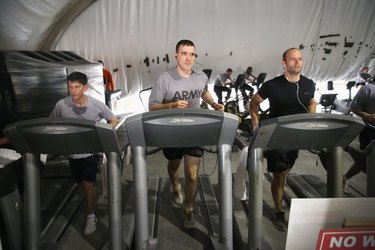
Regardless of your level of fitness, there are seven principles that should be followed during any type of physical training or exercise program. As laid out in the "U.S. Army Fitness Training Handbook," these seven principles also are known as PROVRBS, an acronym for progression, regularity, overload, variety, recovery, balance and specificity.
Progression
Video of the Day
To improve your level of fitness, you need to gradually increase both the intensity and duration of your physical training routine. According to author Robert Sterling Rush in his book "Enlisted Soldier's Guide," a safe level of progression can be achieved by increasing your cardiorespiratory and muscular ability by about 10 percent every 10 days.
Video of the Day
Regularity
It's also important to maintain an exercise regimen that is consistent, with exercise taking place at regular intervals. Physical training ideally should take place between three and five times each week. In addition, it's important to ensure you get adequate sleep and eat properly in order to operate at peak capacity during your physical training.
Overload
Overloading, according to the "U.S. Army Fitness Training Handbook," occurs when the work load of your exercise session exceeds the normal demands you place on your body. This involves pushing yourself so your heart works at a relatively high percentage of its maximum capacity. Determining the proper level of intensity, however, depends on a variety of factors, including age, weight and overall level of fitness. Overloading also takes place during muscular strength and endurance training when you work a muscle to failure.
Variety
It's easy to become bored with physical training if you perform the same routine every time, so it's important to mix things up by breaking up your training routine and include different activities. Not only will this prevent boredom, but it also can increase your motivation and help you achieve better results.
Recovery
The rest periods between physical training are just as important as the training itself, as muscle damage is repaired and waste is metabolized during these times. The optimum recovery time is between 24 and 48 hours after exercise. Recovery also can be achieved by alternating more difficult training days with easier training days, or alternating muscle groups so you're not working the same muscles continually. Improper recovery can lead to muscle fatigue, increasing the potential for subsequent injuries.
Balance
When coordinating a physical training program, it's important to ensure you're exercising all areas of the body equally to achieve a balanced level of fitness. For example, writes Rush in the "Enlisted Soldier's Guide," you should balance routines for the upper body and lower body, and balance endurance running with sprints in order to run as far and as fast as possible.
Specificity
The final principal is specificity, which seemingly contradicts the previous principle of balance by advising you focus on a specific ability during training. More precisely, however, the principle of specificity advises that you gear your training toward specific goals. For example, if your goal is to become a better runner, your training should have a greater focus on running, as activities such as swimming or cycling won't help you achieve this goal as efficiently.